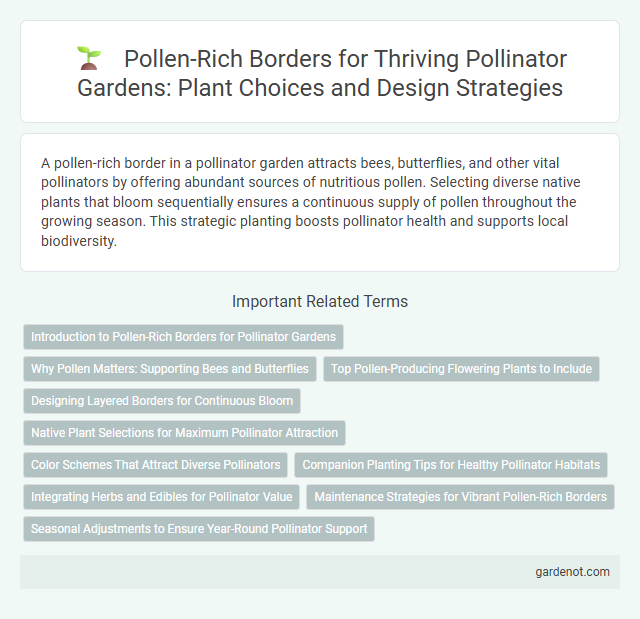A pollen-rich border in a pollinator garden attracts bees, butterflies, and other vital pollinators by offering abundant sources of nutritious pollen. Selecting diverse native plants that bloom sequentially ensures a continuous supply of pollen throughout the growing season. This strategic planting boosts pollinator health and supports local biodiversity.
Introduction to Pollen-Rich Borders for Pollinator Gardens
Pollen-rich borders in pollinator gardens provide a vital food source for bees, butterflies, and other beneficial insects by offering an abundance of pollen from diverse flowering plants. These borders typically contain species such as coneflowers, goldenrod, and bee balm, which bloom at staggered intervals to ensure continuous pollen availability throughout the growing season. Establishing a pollen-rich border promotes pollinator health, supports biodiversity, and enhances ecosystem resilience by sustaining pollinator populations.
Why Pollen Matters: Supporting Bees and Butterflies
Pollen-rich borders provide essential nutrients that support the health and reproduction of bees and butterflies. These insects rely on pollen as a vital protein source to fuel their development and sustain their populations. Establishing concentrated pollen sources enhances pollinator activity, boosting both biodiversity and ecosystem resilience.
Top Pollen-Producing Flowering Plants to Include
In a pollinator garden, incorporating top pollen-producing flowering plants such as sunflowers (Helianthus annuus), bee balm (Monarda didyma), and cosmos (Cosmos bipinnatus) significantly boosts nectar and pollen availability. These species attract a diverse range of pollinators, including honeybees, bumblebees, and native solitary bees, enhancing biodiversity and garden productivity. Selecting pollen-rich borders with these plants supports pollinator health and promotes effective pollination of surrounding crops and wild plants.
Designing Layered Borders for Continuous Bloom
Designing pollen-rich borders with layered plant selections ensures continuous bloom throughout the growing season, attracting diverse pollinators such as bees, butterflies, and hummingbirds. Incorporate early-blooming shrubs, mid-season perennials, and late-flowering plants to provide a steady supply of nectar and pollen. Strategically arranging native species like coneflowers, bee balm, and goldenrod maximizes habitat value and supports pollinator health year-round.
Native Plant Selections for Maximum Pollinator Attraction
Native plant selections such as Echinacea purpurea, Asclepias tuberosa, and Monarda fistulosa create pollen-rich borders that maximize attraction for diverse pollinators including bees, butterflies, and hummingbirds. These species offer abundant pollen and nectar throughout the growing season, supporting pollinator health and biodiversity. Integrating a variety of native perennials ensures continuous bloom periods and optimal habitat for pollinator populations.
Color Schemes That Attract Diverse Pollinators
Pollen-rich borders featuring vibrant color schemes such as purples, yellows, and blues attract a diverse array of pollinators including honeybees, bumblebees, and butterflies. Incorporating native plants like Echinacea, Rudbeckia, and Salvia enhances pollen availability and supports local pollinator populations. Strategic layering of bloom times within these color schemes ensures continuous forage for pollinators throughout the growing season.
Companion Planting Tips for Healthy Pollinator Habitats
Pollen-rich borders enhance pollinator gardens by attracting diverse pollinators such as bees, butterflies, and hummingbirds through a variety of flowering plants like coneflowers, sunflowers, and lavender. Companion planting tips include grouping nitrogen-fixing plants like clover with nectar-rich flowers to improve soil health and boost flower production, creating a sustainable habitat. Incorporating native species alongside herbs such as basil and mint supports a balanced ecosystem by providing food and shelter for beneficial insects.
Integrating Herbs and Edibles for Pollinator Value
Creating a pollen-rich border with herbs and edibles enhances pollinator attraction and supports biodiversity by providing essential nectar and pollen sources. Incorporating plants like lavender, thyme, and basil alongside vegetables such as tomatoes and peppers maximizes foraging opportunities for bees, butterflies, and other pollinators. This strategy increases pollination efficiency and boosts garden productivity while promoting ecological health.
Maintenance Strategies for Vibrant Pollen-Rich Borders
Regular deadheading of spent flowers promotes continuous blooming in pollen-rich borders, enhancing pollinator attraction. Applying organic mulch helps retain soil moisture and suppress weeds, supporting healthy plant growth critical for pollen production. Seasonal pruning and soil enrichment with compost maintain vibrant blooms and nutrient availability, fostering a thriving habitat for pollinators.
Seasonal Adjustments to Ensure Year-Round Pollinator Support
Pollen-rich borders require careful seasonal adjustments to provide year-round nourishment for pollinators like bees, butterflies, and hummingbirds. Incorporating a diverse selection of native flowering plants that bloom sequentially from early spring through late fall ensures continuous pollen availability. Regularly monitoring bloom cycles and replacing spent plants with late-season bloomers sustains the habitat's effectiveness in supporting pollinator populations throughout all seasons.
Pollen-rich border Infographic

 gardenot.com
gardenot.com